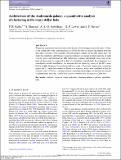Files in this item
Architecture of the Andromeda galaxy : a quantitative analysis of clustering in the inner stellar halo
Item metadata
| dc.contributor.author | Kafle, P. R. | |
| dc.contributor.author | Sharma, S. | |
| dc.contributor.author | Robotham, A. S. G. | |
| dc.contributor.author | Lewis, G. F. | |
| dc.contributor.author | Driver, S. P. | |
| dc.date.accessioned | 2018-01-22T11:30:07Z | |
| dc.date.available | 2018-01-22T11:30:07Z | |
| dc.date.issued | 2017-02 | |
| dc.identifier | 252098179 | |
| dc.identifier | c109b9e9-784c-4842-85d0-6bc8d276900a | |
| dc.identifier | 85014821159 | |
| dc.identifier.citation | Kafle , P R , Sharma , S , Robotham , A S G , Lewis , G F & Driver , S P 2017 , ' Architecture of the Andromeda galaxy : a quantitative analysis of clustering in the inner stellar halo ' , Monthly Notices of the Royal Astronomical Society , vol. 464 , no. 4 , pp. 4858-4865 . https://doi.org/10.1093/mnras/stw2732 | en |
| dc.identifier.issn | 0035-8711 | |
| dc.identifier.other | ArXiv: http://arxiv.org/abs/1610.05920v1 | |
| dc.identifier.uri | https://hdl.handle.net/10023/12552 | |
| dc.description.abstract | We present a quantitative measurement of the amount of clustering present in the inner ∼30 kpc of the stellar halo of the Andromeda galaxy (M31). For this we analyse the angular positions and radial velocities of the carefully selected planetary nebulae in the M31 stellar halo. We study the cumulative distribution of pairwise distances in angular position and line-of-sight velocity space, and find that the M31 stellar halo contains substantially more stars in the form of close pairs as compared to that of a featureless smooth halo. In comparison to a smoothed/scrambled distribution, we estimate that the clustering excess in the M31 inner halo is roughly 40 per cent at maximum and on average ∼20 per cent. Importantly, comparing against the 11 stellar halo models of Bullock & Johnston, which were simulated within the context of the ΛCDM (Λ cold dark matter) cosmological paradigm, we find that the amount of substructures in the M31 stellar halo closely resembles that of a typical ΛCDM halo. | |
| dc.format.extent | 549600 | |
| dc.language.iso | eng | |
| dc.relation.ispartof | Monthly Notices of the Royal Astronomical Society | en |
| dc.rights | © 2016, the Author(s). This work has been made available online in accordance with the publisher’s policies. This is the final published version of the work, which was originally published at https://doi.org/10.1093/mnras/stw2732 | en |
| dc.subject | Methods: statistical | en |
| dc.subject | Stars: individual: planetary nebulae | en |
| dc.subject | Galaxies: individual: M31 | en |
| dc.subject | QB Astronomy | en |
| dc.subject | QC Physics | en |
| dc.subject | 3rd-DAS | en |
| dc.subject.lcc | QB | en |
| dc.subject.lcc | QC | en |
| dc.title | Architecture of the Andromeda galaxy : a quantitative analysis of clustering in the inner stellar halo | en |
| dc.type | Journal article | en |
| dc.contributor.institution | University of St Andrews.School of Physics and Astronomy | en |
| dc.identifier.doi | 10.1093/mnras/stw2732 | |
| dc.description.status | Peer reviewed | en |
| dc.identifier.url | http://arxiv.org/abs/1610.05920v1 | en |
This item appears in the following Collection(s)
Items in the St Andrews Research Repository are protected by copyright, with all rights reserved, unless otherwise indicated.

